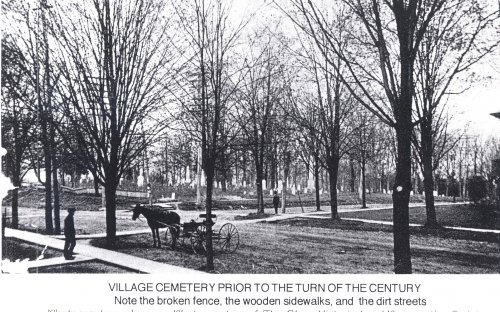From the Olean Historical and Preservation Society:
In lieu of Bernie Pire's feature story (she's been helping out her former employer), we have a paper written by Josh Rogers, an Olean High Junior. He has kindly allowed us to print it here.
In 1807 Major Adam Hoops, pioneer founder of Olean, donated three acres near the center of town (at the end of Laurens St. between 4th and 6th) to be used as a burial ground for Olean's earliest settlers. Among those buried in the Village Cemetery were some of Olean's most prominent settlers like Cornelius Brooks, Judge Timothy H. Porter, Judge Frederick J. Martin, Ebenezer Reed, and Adam's brother Robert, but not Adam.
Over the years the population of the cemetery slowly grew to almost 1300 "residents". As the population grew, however, the general condition of the cemetery worsened. Headstones, toppled over sunken gaves, made the burial ground not only an eyesore, but also a safety hazard. Even though warned of the danger in the cemetery, children and pranksters still found it a favorite local haunt.
In 1892 the village Board of Health decreed that no further burials were to be allowed there and that all bodies be transferred to the new Mt. View Cemetery on the south side of the river.
Finally in 1906, the Board of Park Commissioners hired mortician C.P. Woodard to supervise removal of the bodies. The job of disinterring them took 47 days through the months of April and May. After the bodies were removed, the land was turned into what is now Oak HIll Park. The bodies were transfeerred to Mt. View and Pleasant Valley Cemeteries, and the fact that Oak Hill Park was once a burial ground soon drifted into local legend.
Then, in January 1973, a piece of a monument which, around the turn of the century, had been erected in honor of Major Hoops by Dr. Lambert Whitney, was found. Two weeks later, broken headtstones from Oak HIll were discovered near War Veterans Park. Stephen Gilboy, city historian at that time, concluded that the headstones were removed from the cemetery prior to removal of the bodies. Therefore the bodies to whom the headstones belonged may still, to this date, remain in the park.
Although many of the children who play in Oak Hill Park don't know that it used to be a burial ground, they still feel that it is shrouded in an almost haunting essence. And even though they don't know it, the park is still, in a way, sacred.
From the "Historical Happenings" May-June 2000.




